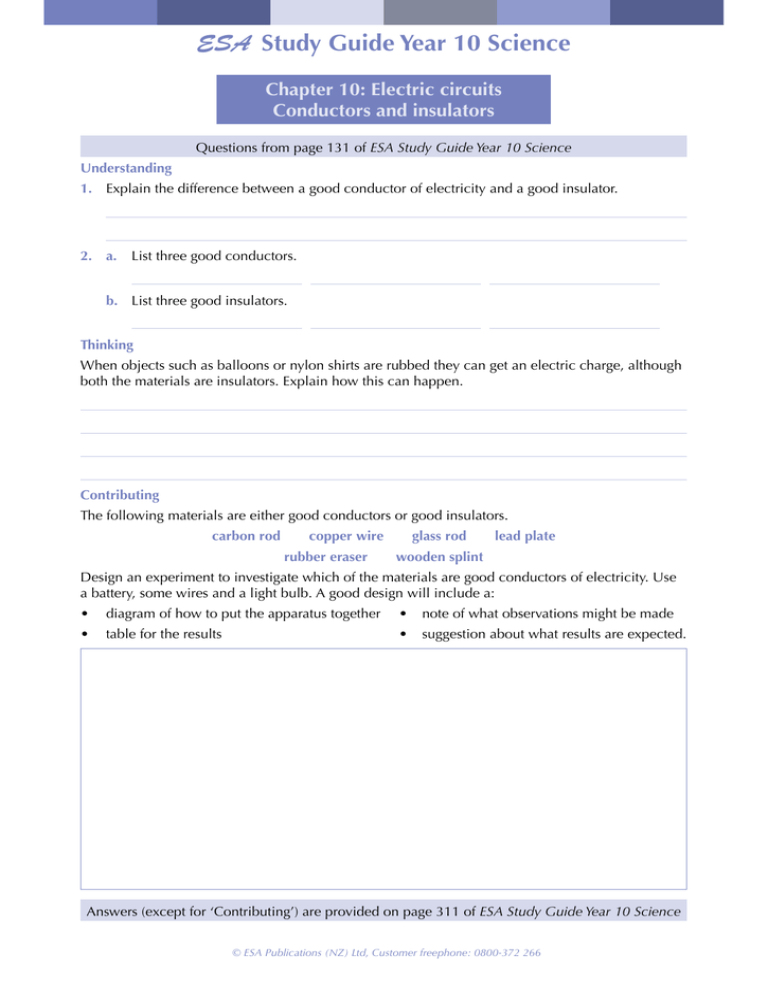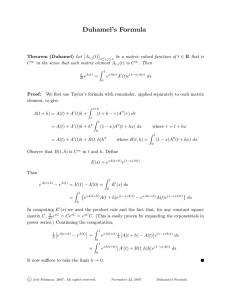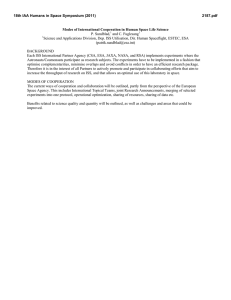Chapter 10: Electric circuits
advertisement

ESA Study Guide Year 10 Science Chapter 10: Electric circuits Conductors and insulators Questions from page 131 of ESA Study Guide Year 10 Science Understanding 1. Explain the difference between a good conductor of electricity and a good insulator. 2. a. List three good conductors. b. List three good insulators. Thinking When objects such as balloons or nylon shirts are rubbed they can get an electric charge, although both the materials are insulators. Explain how this can happen. Contributing The following materials are either good conductors or good insulators. carbon rod copper wire rubber eraser glass rod lead plate wooden splint Design an experiment to investigate which of the materials are good conductors of electricity. Use a battery, some wires and a light bulb. A good design will include a: • diagram of how to put the apparatus together • note of what observations might be made • table for the results • suggestion about what results are expected. Answers (except for ‘Contributing’) are provided on page 311 of ESA Study Guide Year 10 Science © ESA Publications (NZ) Ltd, Customer freephone: 0800-372 266 ESA Study Guide Year 10 Science Chapter 10: Electric circuits Batteries Questions from pages 133, 134 of ESA Study Guide Year 10 Science Understanding 1. Rule lines to match the terms with the definitions. Term a. batteries Definition i. stores energy but cannot be recharged b. electrode ii. store energy in the form of chemicals c. iii. stores energy and can be recharged polarised d. primary cell iv. bubbles of hydrogen form on the electrode e. v. plate of material immersed in electrolyte secondary cell 2. Complete the following: a. A simple cell has negative electrode. Dilute as the positive electrode and acts as the electrolyte. as the b. A simple cell’s defects (problems) are: i. ii. c. A dry cell has as the positive electrode and as the negative electrode. It has paste as the electrolyte and a depolariser consisting of powdered and . Thinking Summa and Ellen investigated making electricity from chemicals. electric meter They had samples of copper, magnesium, zinc, iron, lead, aluminium and nickel metal; a voltmeter; two connecting leads; a 100 mL beaker; dilute sulfuric acid; sandpaper. The sandpaper was used to scrape away any oxide layer on the metal samples to reveal the shiny metal surface. Ellen poured 40 mL of acid into the beaker. copper Summa connected the wires to zinc, copper and the meter. She dipped the metals into the acid so that they did not touch. The reading on the voltmeter (the voltage) and any observations were recorded. The experiment was repeated using copper with all the other samples. Below are their results: Aluminium and copper = 0.9 volts – bubbles! Copper and copper = 0.0 volts – no reaction. Iron and copper = 0.5 volts. Lead and copper = 0.5 volts. Nickel and copper = 0.3 volts. Magnesium and copper = 1.5 volts – magnesium started to dissolve. Zinc and copper = 0.9 volts. 1 © ESA Publications (NZ) Ltd, Customer freephone: 0800-372 266 zinc ESA Study Guide Year 10 Science a. Write down their results in a table. Metal 1 Metal 2 Meter reading (V) Observation b. Why did they sandpaper their samples? c. Which two different metals produced the most voltage? and d. Which two different metals produced the least voltage? and e. Why did using two electrodes made of copper produce no voltage? Contributing Find out how to give first aid to someone who has had an electric shock. Write a paragraph to read to your class or group. Answers (except for ‘Contributing’) are provided on pages 311 and 312 of ESA Study Guide Year 10 Science 2 © ESA Publications (NZ) Ltd, Customer freephone: 0800-372 266 ESA Study Guide Year 10 Science Chapter 10: Electric circuits Simple circuits Questions from pages 138, 139 of ESA Study Guide Year 10 Science Understanding 1. Give two examples of ‘electrical components’. and 2. Alongside is a badly drawn circuit of a cell supplying electricity to a light bulb. Find the three mistakes in the drawing. Thinking 1. Draw a circuit diagram with a cell, two bulbs and a switch in one loop. The circuit should allow both light bulbs to be turned on/off by the switch. 2. State which, if any, of the lamps in each circuit below will be on. All of the switches have been left open. a. b. c. i i i ii iii ii iii d. e. f. i ii i ii ii iii v iv i iii iv v vi vii 3. Draw a circuit with a power supply, two bulbs and two switches, in which each bulb can be turned on/off by its ‘own’ switch. Answers are provided on page 312 of ESA Study Guide Year 10 Science © ESA Publications (NZ) Ltd, Customer freephone: 0800-372 266 ESA Study Guide Year 10 Science Chapter 10: Electric circuits Circuits Questions from pages 140, 141 of ESA Study Guide Year 10 Science Understanding 1. Explain why electricity is dangerous, even in small amounts. 2. Alongside is a simplified drawing of a fire alarm. When a fire occurs, the bimetallic strip gets hot, expands and bends downwards to touch the contact. Explain, in terms of electrical circuits, why the fire alarm then sounds. IPTL[HSSPJ°Z[YPW JSHTWLK LUK contact TL[HS°WPU heat battery bell Thinking 1. Josh and Simon wanted to investigate the relationship between current and the number of cells connected to a light bulb. They wanted to make quantitative measurements of the current flow so they connected an ammeter in series with the light bulb. They built the following circuits. ‘I’ is the symbol for current. A 0°$°(° a. A 0°$°(° A 0°$°(° Write down their results in a table. b. Suggest a value for the ammeter reading if they had connected four cells in the circuit. c. Write a conclusion to their experiment. Answers are provided on page 313 of ESA Study Guide Year 10 Science © ESA Publications (NZ) Ltd, Customer freephone: 0800-372 266


